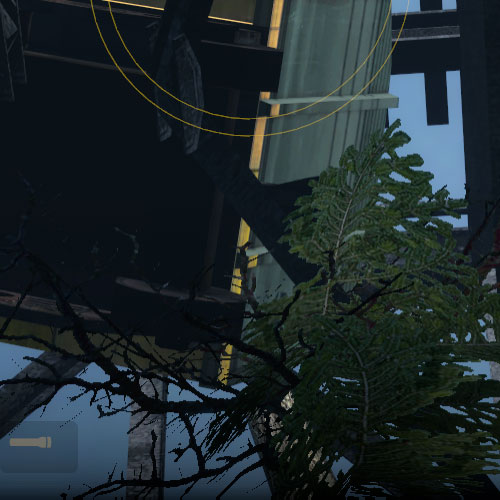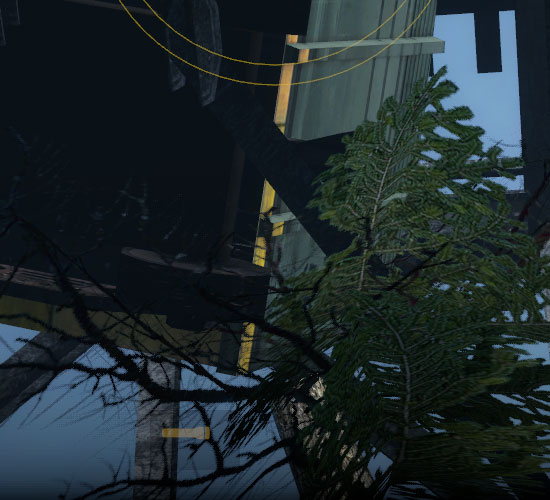AMD's Radeon HD 5870: Bringing About the Next Generation Of GPUs
by Ryan Smith on September 23, 2009 9:00 AM EST- Posted in
- GPUs
The Return of Supersample AA
Over the years, the methods used to implement anti-aliasing on video cards have bounced back and forth. The earliest generation of cards such as the 3Dfx Voodoo 4/5 and ATI and NVIDIA’s DirectX 7 parts implemented supersampling, which involved rendering a scene at a higher resolution and scaling it down for display. Using supersampling did a great job of removing aliasing while also slightly improving the overall quality of the image due to the fact that it was sampled at a higher resolution.
But supersampling was expensive, particularly on those early cards. So the next generation implemented multisampling, which instead of rendering a scene at a higher resolution, rendered it at the desired resolution and then sampled polygon edges to find and remove aliasing. The overall quality wasn’t quite as good as supersampling, but it was much faster, with that gap increasing as MSAA implementations became more refined.
Lately we have seen a slow bounce back to the other direction, as MSAA’s imperfections became more noticeable and in need of correction. Here supersampling saw a limited reintroduction, with AMD and NVIDIA using it on certain parts of a frame as part of their Adaptive Anti-Aliasing(AAA) and Supersample Transparency Anti-Aliasing(SSTr) schemes respectively. Here SSAA would be used to smooth out semi-transparent textures, where the textures themselves were the aliasing artifact and MSAA could not work on them since they were not a polygon. This still didn’t completely resolve MSAA’s shortcomings compared to SSAA, but it solved the transparent texture problem. With these technologies the difference between MSAA and SSAA were reduced to MSAA being unable to anti-alias shader output, and MSAA not having the advantages of sampling textures at a higher resolution.
With the 5800 series, things have finally come full circle for AMD. Based upon their SSAA implementation for Adaptive Anti-Aliasing, they have re-implemented SSAA as a full screen anti-aliasing mode. Now gamers can once again access the higher quality anti-aliasing offered by a pure SSAA mode, instead of being limited to the best of what MSAA + AAA could do.
Ultimately the inclusion of this feature on the 5870 comes down to two matters: the card has lots and lots of processing power to throw around, and shader aliasing was the last obstacle that MSAA + AAA could not solve. With the reintroduction of SSAA, AMD is not dropping or downplaying their existing MSAA modes; rather it’s offered as another option, particularly one geared towards use on older games.
“Older games” is an important keyword here, as there is a catch to AMD’s SSAA implementation: It only works under OpenGL and DirectX9. As we found out in our testing and after much head-scratching, it does not work on DX10 or DX11 games. Attempting to utilize it there will result in the game switching to MSAA.
When we asked AMD about this, they cited the fact that DX10 and later give developers much greater control over anti-aliasing patterns, and that using SSAA with these controls may create incompatibility problems. Furthermore the games that can best run with SSAA enabled from a performance standpoint are older titles, making the use of SSAA a more reasonable choice with older games as opposed to newer games. We’re told that AMD will “continue to investigate” implementing a proper version of SSAA for DX10+, but it’s not something we’re expecting any time soon.
Unfortunately, in our testing of AMD’s SSAA mode, there are clearly a few kinks to work out. Our first AA image quality test was going to be the railroad bridge at the beginning of Half Life 2: Episode 2. That scene is full of aliased metal bars, cars, and trees. However as we’re going to lay out in this screenshot, while AMD’s SSAA mode eliminated the aliasing, it also gave the entire image a smooth makeover – too smooth. SSAA isn’t supposed to blur things, it’s only supposed to make things smoother by removing all aliasing in geometry, shaders, and textures alike.
As it turns out this is a freshly discovered bug in their SSAA implementation that affects newer Source-engine games. Presumably we’d see something similar in the rest of The Orange Box, and possibly other HL2 games. This is an unfortunate engine to have a bug in, since Source-engine games tend to be heavily CPU limited anyhow, making them perfect candidates for SSAA. AMD is hoping to have a fix out for this bug soon.
“But wait!” you say. “Doesn’t NVIDIA have SSAA modes too? How would those do?” And indeed you would be right. While NVIDIA dropped official support for SSAA a number of years ago, it has remained as an unofficial feature that can be enabled in Direct3D games, using tools such as nHancer to set the AA mode.
Unfortunately NVIDIA’s SSAA mode isn’t even in the running here, and we’ll show you why.

5870 SSAA

GTX 280 MSAA

GTX 280 SSAA
At the top we have the view from DX9 FSAA Viewer of ATI’s 4x SSAA mode. Notice that it’s a rotated grid with 4 geometry samples (red) and 4 texture samples. Below that we have NVIDIA’s 4x MSAA mode, a rotated grid with 4 geometry samples and a single texture sample. Finally we have NVIDIA’s 4x SSAA mode, an ordered grid with 4 geometry samples and 4 texture samples. For reasons that we won’t get delve into, rotated grids are a better grid layout from a quality standpoint than ordered grids. This is why early implementations of AA using ordered grids were dropped for rotated grids, and is why no one uses ordered grids these days for MSAA.
Furthermore, when actually using NVIDIA's SSAA mode, we ran into some definite quality issues with HL2: Ep2. We're not sure if these are related to the use of an ordered grid or not, but it's a possibility we can't ignore.
If you compare the two shots, with MSAA 4x the scene is almost perfectly anti-aliased, except for some trouble along the bottom/side edge of the railcar. If we switch to SSAA 4x that aliasing is solved, but we have a new problem: all of a sudden a number of fine tree branches have gone missing. While MSAA properly anti-aliased them, SSAA anti-aliased them right out of existence.
For this reason we will not be taking a look at NVIDIA’s SSAA modes. Besides the fact that they’re unofficial in the first place, the use of a rotated grid and the problems in HL2 cement the fact that they’re not suitable for general use.












327 Comments
View All Comments
ilnot1 - Wednesday, September 23, 2009 - link
In fact, going by the lowest Newegg prices, this is how the top setups would stack up today:5870 CF .......= $760
GTX 285 SLI .= $592
GTX 295 .......= $470
GTX 275 SLI .= $420
5870 ............= $380
4890 CF ........= $360
4870 X2 ........= $330
This would make the 4890 CF or the 275 SLI setups the best value. And yes I realize there will be availability issues and price adjustments over the next month or so.
DominionSeraph - Thursday, September 24, 2009 - link
you forgot:4870 CF: $260-280
and how about the $180 4850 CF, which is probably the best price/performance for sub-1920x1200 gaming. http://www.anandtech.com/video/showdoc.aspx?i=3517...">http://www.anandtech.com/video/showdoc.aspx?i=3517... You can even get 1GB versions for ~$190.
ilnot1 - Wednesday, September 23, 2009 - link
Another very good review, thanks.But piggy backing on what wicko said, I'm surprised you didn't include two 4890 in CF. Seeing as how you can get two 4890 for less than a 5870 (whenever they are actually available). $180 x 2 = $360 < $379. And this from Newegg, not some super special sale price.
http://www.newegg.com/Product/Product.aspx?Item=N8...">http://www.newegg.com/Product/Product.aspx?Item=N8...
Ryan Smith - Wednesday, September 23, 2009 - link
It's something we would have included if we had the cards. I don't have 2 4890s, and we couldn't get a second one in time.AnotherGuy - Wednesday, September 23, 2009 - link
as always anandtech roxnbjsl2000 - Wednesday, September 23, 2009 - link
Finally time to upgrade..SiliconDoc - Wednesday, September 23, 2009 - link
Not only all that, but when there were 13 big titles for PhysX and a hundred smaller ones, we were told here, "Meh", who needs it.Now, we have a papery and unavailable (egg)except by pre-order(tiger) 5870 launch, a not-existing 5850, with guess what ? NO DX11 games!
Oh wait, there is actually just ONE - see page 7 of review. LOL
---
Conclusion ?: " It looks like NO(err.. just one) DX11 games ready, so... it also looks like NVidia is launching at the right time, and ATI blew their dry unimpressive wad on a piece of paper porn. "
---
Gee no one crowing about the first DX11 card... imagine that...
Good thing , too, considering how 13 big or a hundred titles small of PhysX enhanced games was "nothing to change one's purchase decision over". At least Anand got addicted to Mirror's Edge with PhysX enabled before concluding in the article "meh" this PhysX thing is ok if you like this game, but who cares...
---
Now we have the DX11 pre DX11 games launch with a paper product, so crowing about it wouldn't be too fitting, huh.
monomer - Wednesday, September 23, 2009 - link
Why would a developer would release a DX11 game before DX11 is even available?SiliconDoc - Friday, September 25, 2009 - link
Why would a developer release a DX11 card before DX11 is even available ?(I suppose you'll have to unscrew your hate nvidia foil cap, and grind in the red spikes in it's place to answer that one.)
However, allow me, instead.
1.I have been running windows 7 32&64 for quite some time now, not sure why you haven't been.
2. Battleforge, an ATI promo game, as noted in the review, has released their DX11 patch, hence, with W7 from MSFT (the beta+ free trial good till March 1st 2010 or something like that) I believe any gamer has had a reasonable chance to preview DX11.
---
So anyway...
cactusdog - Friday, September 25, 2009 - link
Ya , ATI has done it again. Excellent performance for a fair price. If Nvidia released this exact card it would be $150-$200 more expensive.LOL, Nvidia sales are gonna be slow for a while.